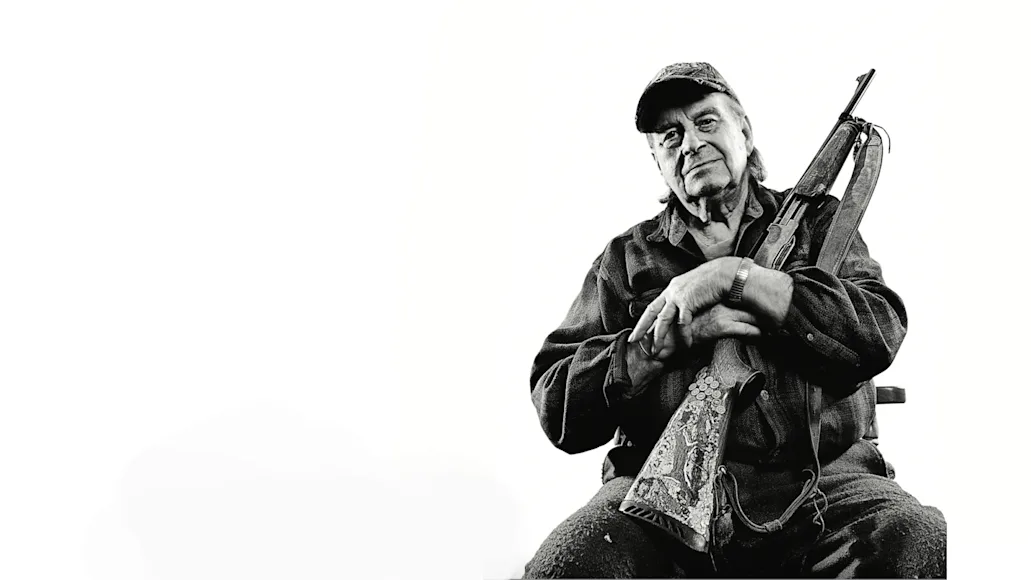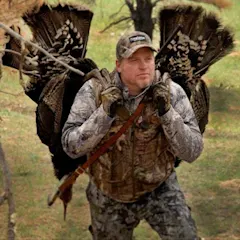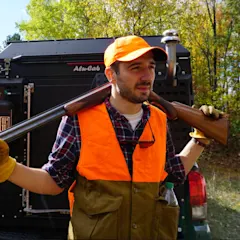There are deer all over the world that have been hunted since the very beginning, but you won’t find Ook or Grog here, nor Robin Hood killing the king’s deer. This is a list of the greatest American deer hunters. Even so, Boone and Crockett don’t make the cut, either, nor Pope or Young—because here we are talking about hunters best known for their skill at taking whitetail deer specifically and for their part in advancing the sport of whitetail deer hunting.
You won’t find many young hotshots, either. It’s not that we have anything against youngsters. It’s because it takes decades to build a body of work and often much longer to see the full view of any one deer hunter’s influence on the sport.
And so, with all of that out of the way, here are 39 of the greatest American whitetail deer hunters of all time—mostly old-school and a few new-school influencers who, yes, stacked up bucks, but, more important, shaped the way we hunt today and how we see ourselves as deer hunters.
1. Chief Massasoit, The Giver of Deer

Not long after the Mayflower landed in Plymouth Bay, Puritan leader William Bradford invited 90 Wampoaug Indians to a harvest feast in October of 1621—now often referred to as the first Thanksgiving. Realizing upon arrival just how skimpy the meal would be, Chief Massasoit (1581-1661) dispatched his hunters, as the story goes, who quickly secured enough venison to feed 140 celebrants for three days. Native Americans were the original whitetail deer hunters, of coruse, using tactics many of us consider modern, including decoying and rattling. But Massasoit gets the nod for the symbolic significance of his gift of deer and deer hunting—to the colonists and ultimately to all of us.
2. Nat Foster, The Original Deerslayer

Boone and Crockett, both legendary hunters in their own right, shaped the mythos of the American backwoodsman. But it was the fictional Natty Bumppo of James Fenimore Cooper’s Leatherstocking Tales who cemented the American deer hunter, specifically, as a cultural hero—rugged, steady, trustworthy, upright. Historians advance several candidates as Bumppo’s real-life counterpart. As likely as not, and according to a 1937 report in The New York Times, renowned Adirondack deerslayer Nat Foster (1766-1840) gave Cooper his protagonist. Like Bumppo, Foster was a supremely skilled hunter and crack shot with a long rifle. Unlike Bumppo, he was no cardboard hero and none too friendly with the natives. He was suspected of killing many and was tried and acquitted for the murder of one. Nonetheless, as the inspiration for Bumppo, there may be no real-life hunter so influential in casting deer hunters in a golden light.
3. John James Audubon, The Hunter Naturalist
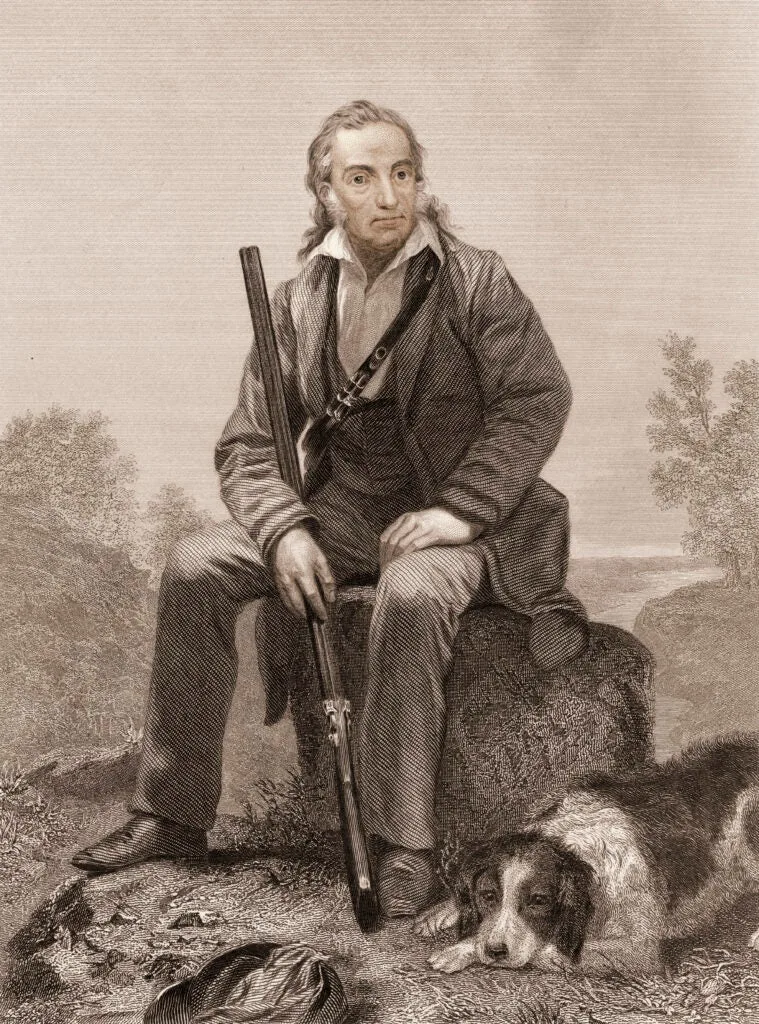
Although not widely celebrated as a deer hunter, Audubon (1785-1851) was an avid whitetail devotee, and, along with Foster, a strong candidate for Cooper’s real-life Natty Bumppo. Audubon’s influential 1831 essay “Deer Hunting,” widely read in his day and in print for well over a century, was (1) the first serious how-to manual detailing the popular deer hunting tactics of the time; (2) a romanticized case for deer hunting as noble recreation; and (3) an early argument for fair-chase hunting. Audubon is America’s original hunter-naturalist, who, as deer hunting historian Robert Wegner writes in his excellent Legendary Deerslayers, “studied deer to hunt them and hunted them to study them.”
4. Meshach Browning, The Buck Brawler

Meshach Browning (1781-1859) was not the first to chronicle hunting life on the early frontier, but his Forty-Four years of the Life of a Hunter focuses more squarely on deer than others. Although equally known as a bear hunter, Browning had a reputation as a deerslayer of legendary drive and toughness. His knife fight with a wounded 10-point buck in October 1819 became the subject of a the famous subject of a popular Currier and Ives lithograph made in 1861, and painted by the great A.F. Tait. Browning chronicled the hunt with charm and authenticity in what remains one of the most important records of pioneer deer hunting.
5. Judge John Dean Caton, The Original Deer Doctor

It’s not unusual these days for prominent deer biologists to mingle hard science with popular hunting craft, but this isn’t new. Judge John Dean Caton (1812-1895), a Chief Justice of the Supreme Court of Illinois, preceded today’s PhD hunters by more than a century. Although not a formally trained scientist, Caton studied deer with a rigorous, systematic approach. In 1858, he created the country’s second deer park, a 200-acre enclosure for observing deer. That said, the wilds were also his laboratory, and hunting a favorite scientific method. In 1877, he published The Antelope and Deer of America, the first scientific treatise on deer and deer hunting. Forest and Stream, precursor to Field & Stream, called it “the most important publication ever printed on the subject….”
6. Fred Bear, America’s Bowyer

A Detroit native, Bear won the Michigan State Archery Championships three times during the 1930s, and sensing the growing interest in bowhunting, began making bows. His Grizzly recurve is widely regarded as the first mass-produced bow in history. Today, the company that bears his name is a leading manufacturer of traditional and compound bows. Fred Bear traveled worldwide, filming bow hunts that hit local American theaters and primed a generation of bowhunters to follow in his footsteps. Although he hunted from Alaska to Africa, Bear’s favorite quarry remained the whitetail deer he pursued in Northern Michigan. One of the founders and original board members of the Pope and Young Club, he was one of the first inductees into the Bowhunter’s Hall of Fame.
7. Larry Koller, The Complete Hunter
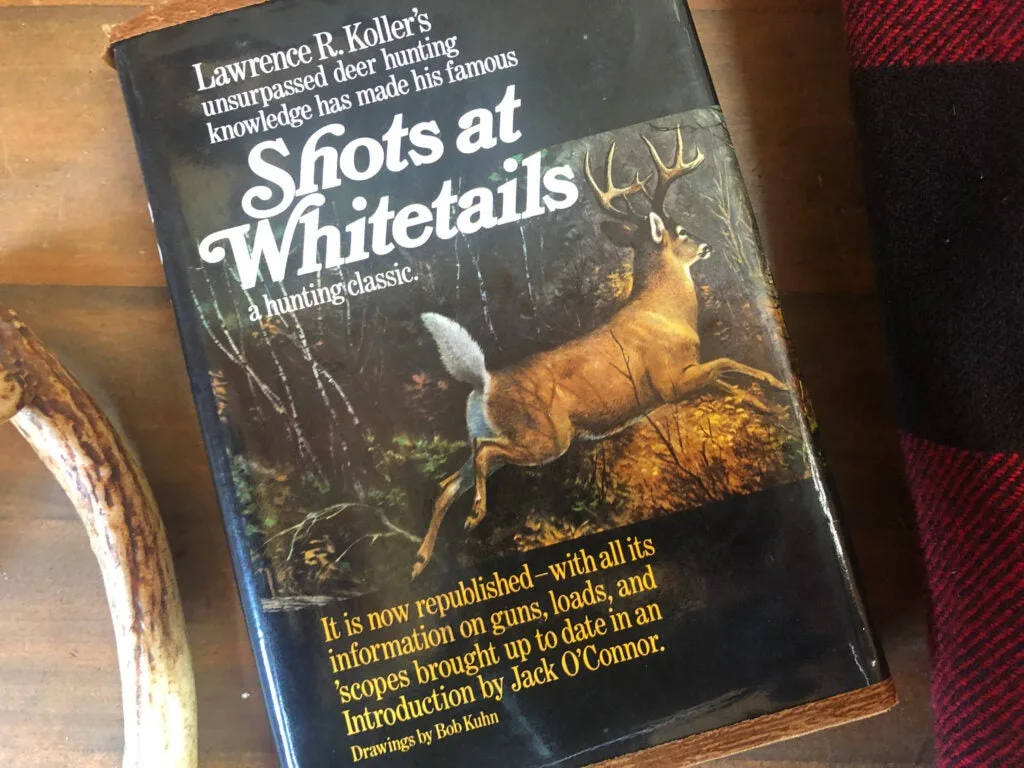
Any one hunter might routinely outsmart deer. Another may shoot them expertly with gun or bow—even with a bow of his own making or a gun of his own smithing. A few are gifted taxidermists, other skilled butchers, or fine cooks when preparing venison. But Larry Koller (1912-1967) was all of these things. And he could write about all of it with great deft. Jack O’Connor called Koller’s Shots at Whitetails “the best book on deer hunting since Van Dyke’s The Still-Hunter.” A far more complete guide, the former has become the better-known classic. What little of Koller’s tome that is not still of practical use today is a window into a time when deer were not behind every bush and tagging a good one every year required uncommon skill. When “experts” actually had to prove themselves, Koller was the real deal.
8. Larry Benoit, The Buck Tracker
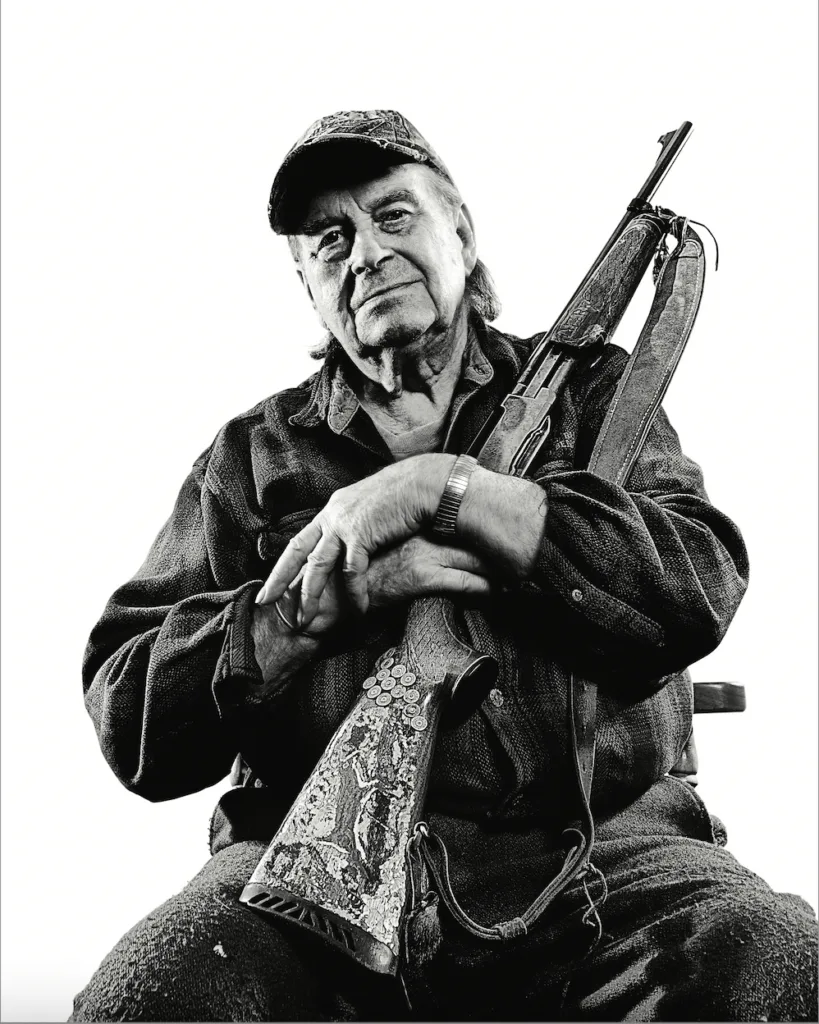
Growing up on a hardscrabble farm in the mountains of Vermont during the great depression, Larry Benoit (1924-2013) learned to follow the biggest deer track for one reason: it meant more food on the table. Soon he had an unparalleled record of bagging huge bucks in the big woods of northern New England. In 1970, he was named “The Best Deer Hunter in America” by Sports Afield magazine, and his 1975 book How to Bag the Biggest Buck of Your Life turned generations of stump sitters into active hunters. He co-authored several more books with his sons Lanny, Shane, and Lane. But the boys take a backseat to their pops, who is widely considered the best deer tracker of all time. Larry Benoit’s legacy can still be seen today on late-season mornings across the Northwoods, when legions of hunters take to the snowy woods clad in the man’s signature green-checkered wool jacket and carrying his signature Remington pump rifle. They are looking for large, fresh tracks to follow, but they are also following in Benoit’s footsteps, using skills he passed on and a hunting style he popularized.
11. Dr. Joe Hamilton, The Deer Manager

Deer management prior to the 1980s was primarily a maintenance game; most states were simply happy to have a deer season at all, much less worry about the sex or age structure of the herd and its impact on the landscape and other species. In Texas, however, a new type of deer management was taking hold, the principals of which were published in the book, Producing Quality Whitetails, by Al Brothers and Murphey E. Ray, Jr. The landmark work kicked off the quality-deer-management movement, and Al Brothers is deservedly regarded as its founder. But it was his protege, Joe Hamilton, who formally launched the Quality Deer Management Association in 1988 and put the acronym “QDMA” on the lips of deer hunters all around the country. Hamilton, a highly respected biologist and researcher who enjoyed a 20-year career with the South Carolina DNR, brought the core principles of QDMA to not only state agencies but the ordinary deer hunter. The main tenets were still revolutionary at the time: maintain an adequate doe harvest to keep herd numbers in check and protect a portion of the yearling buck population. Now, they are gospel to untold numbers of serious deer hunters, which includes Hamilton himself.
12. John Wootters, Mr. Whitetail

Author of the classic book Hunting Trophy Deer, native Texan John Wootters (1928-2013), aka "Mr. Whitetail," was a former Field & Stream columnist and the long-time “Buck Sense” columnist for Petersen’s Hunting. His writing focused mainly of whitetails, and his stories were frequently inspired by hunts and experiences from his Los Cuernos ranch in the Brush Country of South Texas, which he owned alongside his wife, Jeanne. The low-fence operation was seen as a model of trophy buck management decades before “land management” was a part of whitetail hunting culture. To this day, Wootters is celebrated as a pioneer of modern whitetail hunting tactics.
13. Larry Weishuhn, The Other Mr. Whitetail

Another Texan, also known as “Mr. Whitetail,” Larry Weishuhn may not have invented rattling antlers and handgun hunting, but he certainly helped popularize them through his numerous articles, speaking engagements, and video and television appearances. Weishuhn, who was born in 1947, graduated Texas A&M in 1970 and worked for the Texas Parks and Wildlife Department for years as a biologist before moving to the private sector as a wildlife consultant, writer, and hunting personality. During the heart of the whitetail boom and surging big-buck craze, Weishuhn held sway as one of the country's top hunting authorities. Today, Weishuhn is busy as ever penning articles, hosting podcasts and television shows, and traveling the country to hunt big whitetails.
14. Brad Harris, The Call Maker

The first deer Brad Harris ever grunted in was a little 6-point buck. Harris was bowhunting Mingo Swamp in Missouri back in the 1970s, after a friend he worked with in the coal mines had told him about hearing a buck grunt. Harris had been practicing the sound with his own voice, and so, as the deer passed out of range, the hunter pinched his nose and gave it a try. The buck turned and strolled right to the base of his tree. Harris says he got nervous and missed, but that he walked away from the experience knowing that a grunt call could be a valuable tool for deer hunters. He went to work for the Lohman Game Call company, where he helped bring the first grunter to the commercial market. The design for that call was pretty much the same one used by thousands of deer hunters to this day.
15 & 16. Dick Idol & Gordon Whittington, The Magazine Makers

Back in the early 1980s, a new kind of magazine launched with a risky, ground-breaking plan; the entirety of each issue would be devoted to hunting just one species—the whitetail deer. Obsessed whitetail hunter and trophy antler collector Dick Idol, who toured the country with his personal collection of trophy racks, including the famous Hole in the Horn buck, believed that readers would devour all the big-buck content they could get their hands on. To test the theory, he and the magazine's co-founders put out a single issue of North American Whitetail in the fall of 1982—and it flew off the shelves.

North American Whitetail editor Gordon Whittington shepherded the growth of the magazine for more than three decades and, in the process, introduced other whitetail nuts to the concepts of deer management, covered hunting techniques from the country’s top trophy hunters, and broke stories on some of the greatest whitetails in history, including the Milo Hanson buck. More than 40 years later, people still can't get enough trophy whitetail content, and they still count of North American Whitetail to provide it.
17 & 18. Gene and Barry Wensel, The Twin Killers

Also in the 1980s, word began spreading among bowhunters about a pair of twin brothers who were killing the heck out of big Montana whitetails—and doing it with recurve bows, which even then had largely been replaced by flatter-shooting and easier-to-use compounds. When Gene and Barry Wensel released their now-classic video Bowhunting October Whitetails, hardcore deer-hunting archers watched it again and again, as the Wensels killed great bucks from tree stands, ground setups, even on drives—arrowing deer on the run. Did I mention they shot recurves?
Gene’s first book, Hunting Rutting Whitetails, was one of the first written by a true expert on the subject and was hugely popular. After guiding on Montana’s Milk River for many years, the brothers pulled up stakes and moved to southern Iowa, where they continued to take giant bucks with traditional gear, producing a library of popular books and videos on the subject. Barry's latest book, The Old Man and the Tree—A Different Approach to Deer Hunting came out just last year.
19. Bill Jordan, The Show Man
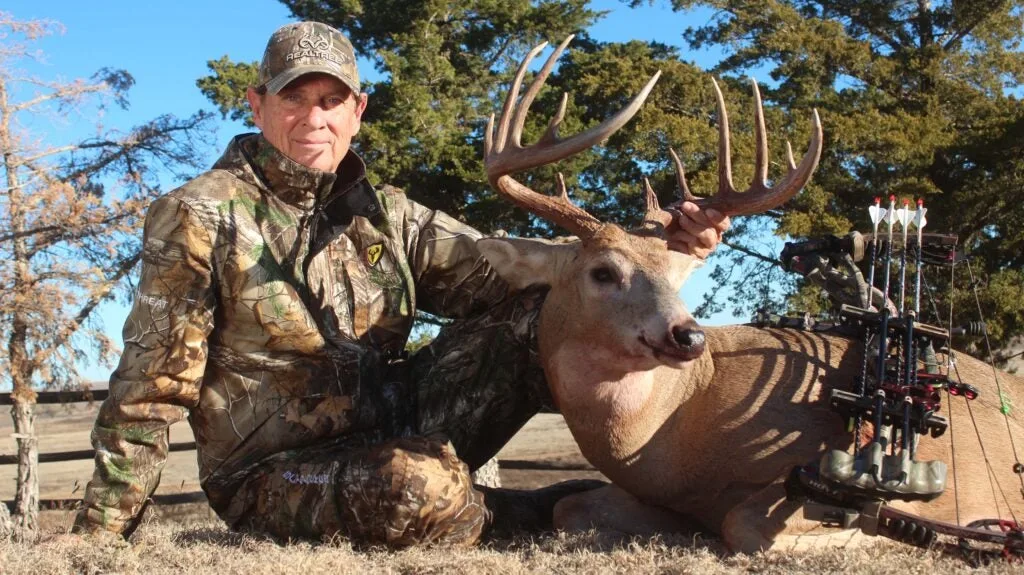
Bill Jordan has taken a pile of big bucks, and he (along with Jim Crumley of Trebark and Toxey Haas of Mossy Oak) led the “camouflage revolution” back in the mid-80s. But that’s not why he makes the list. It helps, but what sets Jordan apart is that early on, he harnessed the power of media and celebrity—tapping the likes of Dale Earnhardt and Jeff Foxworthy—to bring deer hunting into folk’s living rooms. Jordan introduced Realtree Outdoors to television audiences in 1992, on TNN. The video “Monster Bucks of North America” came a year later, and what followed was a big-buck video/dvd craze that continues to this day, including with the July 2021 release of Monster Bucks XXIX. Jordan’s productions were must-watch viewing for many hardcore whitetail nuts, and, for better or worse, propelled toward the (perhaps inevitable) big-buck obsession that so defines deer hunting today. Jordan, as much as anyone, spawned the modern deer-hunting entertainment business—and tagged untold numbers of monster bucks along the way.
20. Greg Miller, The Rub Hunter

Wisconsin hunter Greg Miller got his start writing for magazines like North American Whitetail and Deer & Deer Hunting about fooling trophy big-woods bucks on public land. But it was his books, Aggressive Whitetail Hunting, Proven Whitetail Tactics, and Rub Line Secrets that quickly gained him a larger national audience. The Vietnam vet and former construction worker wrote in a clear voice about the importance of year-round scouting, reading buck sign, and aggressive hunting strategies, particularly for bowhunters. Soon the full-time writer became a fixture on outdoor television, with regular appearances on productions from Realtree, Hunter’s Specialties, and North American Whitetail, as well as his own show that he produced with his son. To today's bowhunters, the practice of reading and setting up on rub and scrape lines for big buck may seem obvious, but it was, to a significant degree, Greg Miller who made it so.
21. John Eberhart, The Dean of DIY

DIY deer hunts on public land are all the rage these days, with growing contingent of young guns eschewing the luxury of hunting on private, managed properties. Well John Eberhart, a Michigan native with 57 seasons under his belt, was perfecting that very style of hunting before most of these youngsters were even born. Wolverine State whitetail hunters are as passionate as they come, but the state is known far more for numbers of deer than for record book entries. That didn't faze Eberhart, who has taken 55 P&Y class bucks (35 from Michigan, the rest from other states) all on public or free-access private land, and none over bait. Eberhart has written for and been featured in many of the country's top hunting magazines and currently hosts trophy whitetail "boot camps" designed to teach others his scouting, preparation, and hunting techniques. Eberhart didn't invent tagging big whitetail bucks on public land, but he is often credited with perfecting it and cited as a role model to today's public-land deer hunters.
22. Hal Blood, The Woodsman

Larry "The Legend" Benoit sparked a fire in the imaginations of would-be deer trackers everywhere, and no one has fanned the flames since more than Hal Blood. An early adopter of YouTube, Blood's deer tracking videos lifted the curtain on an otherwise a mysterious way to hunt and revealed pragmatic, repeatable skills that other big-woods hunters could master.
His book Hunting Big Woods Bucks is an instruction manual on the subject, and if you can’t glean enough lessons there, just go to one of his seminars, listen to his podcasts, or watch any of the hours of video content his team has created. Blood is so good at teaching others to track bucks because he’s spent the last 50-plus years doing it, and he has a wall (more like four walls) of big woods bruisers to prove his methods. If there’s anyone alive today who embodies what it is to be a buck tracker and a true woodsman, it’s Blood, who has become a legend in his own right.
23. Micheal Waddell, The Joker

For well over a decade, Michael Waddell was and may well still be the most widely recognized deer hunter in America. Anyone who can make that claim is going to have a big impact. Waddell, famously from Booger Bottom, Georgia, got his start by winning a Realtree turkey calling championship. Bill Jordan quickly saw his appeal and put him to work behind and eventually in front of the camera. Realtree Roadtrips debuted in the early 2000s, and Waddell’s infectiously fun personality propelled him to new heights of deer-hunter stardom. He traveled all over the country for the show, but being a proud Southern boy, Waddell was always at heart a turkey and whitetail hunter, and he hung a tag on plenty of great bucks while we watched. So what, besides prompting a generation of deer hunters to call bucks “That Joker” and “Mac Daddy,” has Waddell contributed to the sport? Prior to Realtree Roadtrips, deer hunting on TV and video focused on the pursuit, as something we do. Waddell presented it as who we are—deer hunting as a lifestyle. Everyday hunters saw themselves in him and liked it. He made deer hunters proud.
24. Mark Drury, The Pro

If ever there was a professional deer hunter—someone who is highly skilled at his craft and never misses a business opportunity—it’s Mark Drury. First off, he is a hell of a hunter. Drury initially gained notice as a competitive turkey caller—he’s won over 150 competitions, including six world titles—and when he and his brother Terry formed Drury Outdoors in 1989, their first VHS tape “King of Spring” was devoted to gobblers. But Drury, aways able to spot a trend and react quickly, saw that what people wanted to watch was big deer, and specifically, big deer taken with archery equipment. When he killed the largest whitetail ever recorded on tape in 1998, it was off to big-buck races for Drury. In the two-plus decades since tagging that Illinois giant, Drury has established himself as a leading expert on managing, patterning, calling, and killing mature deer, all while building a hunting-entertainment brand that is always on the cutting edge of TV, video, and social media. That has kept Mark Drury at the top of the deer-hunting heap for more than three decades.
25 & 26. Lee and Tiffany Lakosky, The It Couple
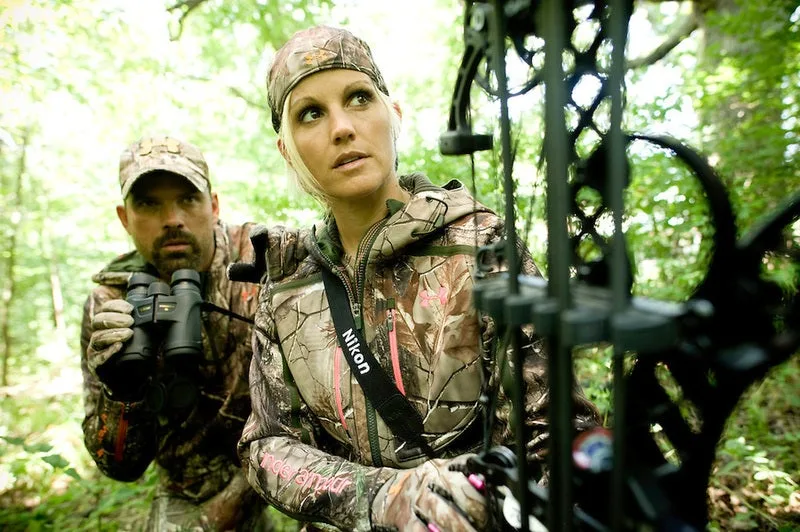
Men and women have been hunting alongside one another since we carried spears, and Lee and Tiffany Lakosky certainly weren't the first couple to do so. But at the height of outdoor TV's popularity, they were the couple—to the point where they are probably the only two deer hunters you can think of who are immediately recognized by their first names only. The Lakoskys are on this list partly because of their success as deer hunters, but mainly because there is no telling how many husband and wives and boyfriends and girlfriends they inspired to make chasing whitetails a central part of their connection with one another. Tiffany, in particular, is on this list because you need only witness the swarms of young (and no-so-young) female hunters and would-be hunters who show up when she attends a hunting show.
When they started filming their hunts, the couple’s “it” factor was undeniable, and their shows The Crush and Gettin’ Close proved hugely popular. Lee gets credit for spearheading their career in outdoor TV, and Tiffany stands out for her impact on recruiting female hunters. In the entire history of deer hunting, can you think of anyone who has spurred more girls and women to take up whitetail deer hunting?
27. Sam Collora, Mr. Doe Pee

There are better-known deer hunters who have tagged more whitetails than Sam Collora—but very, very few can match the size of the bucks on this man’s wall. In 1996, the Iowa native arrowed what was then the highest-grossing archery buck of all time, a 233-inch colossus that threatened the P&Y typical world record, and thrust Collora into the national spotlight. While most hunters who kill a truly world-class buck are one-and-done when it comes to repeating the performance, Collora was just getting warmed up. In the 27 seasons since, Collora has tagged three more gross-200-plus-inch giants, not to mention a collection of other Booner and P&Y trophies.
Collora and his wife run a deer-scent business called Mrs. Doe Pee, and their busiest time is—you guessed it—during the hunting season. The fact that Collara tags world-class bucks on a consistent basis while maintaining a regular job and life serves as testament to his skill.
28. Melissa Bachman, the Self-Starter
At a time when a growing number of outdoor-TV couples were encouraging women to join their boyfriends and hubbies on the hunt, Minnesota native Melissa Bachman reminded them that they could be badass whitetail hunters all on their own. Growing up in a hunting family, Bachman was a serious hunter from childhood and eventually parlayed a broadcast journalism degree into an internship at North American Hunter magazine and TV show. There, she perfected her skills behind, and eventually in front of, the camera, making her a perfect candidate to host her own show. She did exactly that when Winchester hired her to headline their Deadly Passion series, which Bachman still produces, edits, and stars in. While Deadly Passion takes her around the world, Bachman continues to return to her roots as a deer hunter, taking great bucks with bow, rifle, and muzzleloader. She remains active on the deer show circuit, where she draws huge crowds of female hunters whom she has inspired, as well as young would-be hunters looking to follow her lead.
29. Bill Winke, The Hunt Streamer
Bill Winke got his start as a prolific and respected outdoor writer, but when he sensed the print market was fading, he decided to launch a web-based real-time hunting show devoted strictly to whitetail deer hunting and land management, with weekly hunts, tips, and land-management advice from Winke and a team of experts. Midwest Whitetails was a huge hit, ushering in a wave of other upstart web-based whitetail shows and utterly transforming the way serious whitetail nuts get their content. Though he has since sold his interest in the popular series, Winke continues to hunt and manage land, and maintains a YouTube channel dedicated to those pursuits. He also hosts Hoyt’s Bowhunting Whitetails.
30 - 32. Whitetail Properties Founders, The Dream Makers

Not long ago if you wanted to buy your dream hunting property, there were very few real-estate agents who could help. Sure, they could find properties, but most wouldn't have a clue about the land's trophy whitetail potential, let along how to manage it for deer. That all changed in 2007, when Dan Perez, Paul Sawyer, and Pete Alfano founded the Pike County, Illinois-based agency Whitetail Properties. From the outset, the company marketed its agents as not just real estate professionals but also experts on trophy whitetail land management, food plots, and hunting tactics—and they could back it up with knowledge and experience. Whitetail Properties agents have long been required to complete the Level II Deer Steward certification course offered by the National Deer Association (formerly the QDMA), and several of them, including the three founders, have enviable track records for killing giant whitetails. They have been quoted as experts countless times in the pages of F&S. Today, for just about anyone looking to buy their dream deer hunting property, Whitetail Properties is the first real-estate agency that comes to mind.
33. Levi Morgan, the Deadeye

Plenty of competitive tournament archers are serious hunters, but no one has married the two pursuits—and influenced a generation of bowhunters to improve their technical knowledge and skill—more than Levi Morgan. Raised in rural North Carolina, Morgan started hunting and shooting a bow as a youngster, entering his first competitive shoot when he was only 5 years old. Through high school he turned his competitive nature to basketball and baseball and was so successful in those sports that he was offered scholarships that would have paid for his college career. Instead, he decided to take his shot as a full-time tournament archer. Morgan was named Rookie of the Year in his first season, went on to win Shooter of the Year 10 different times, and is now generally regarded as the GOAT. Meanwhile, no one has done more to inspire—and teach—everyday bowhunters to be the best and most accurate archers they can be. In 2008, Morgan and his wife Samantha, who is also a successful tournament archer, started a TV show devoted to big-game hunting with a bow. The Bow Life remains a hit with fans and the perfect venue to witness what a truly great bow shot can accomplish in the whitetail woods.
34. Dan Infalt, The Hunting Beast

About a decade ago, all the experts said that to kill big deer, you had to intercept them at food sources or in travel corridors, but leave them alone in bedding areas. Wisconsin native Dan Infalt, founder of The Hunting Beast, always called b.s. on that. Infalt is an old-school bowhunter who was using aggressive, mobile tactics on public land long before they were cool. He says that deer are mostly nocturnal, and old ones especially so. But they move about a bit in the daylight, near their beds, each day. Being there when they stand to stretch is the best way to kill them consistently, according to Infalt, and he’s arrowed dozens of giant public-land whitetails to prove it. He’s a regular guest on many of today’s most popular hunting podcasts and YouTube channels and has arguably done more than anyone to influence today’s most popular public-land hunting tactics.
35-39. The Hunting Public, Everyman Influencers

Back in the heyday of hunting television, the most popular shows featured highly produced hunts for B&C-caliber animals filmed from multiple camera angles. To accomplish that, the shows were filmed almost exclusively on managed private land. The average workaday hunter might’ve been entertained—but couldn’t relate. Aaron Warbritton, Zach Ferenbaugh, Jake Heubschman, and Greg Clements—all young interns for Bill Winke’s Midwest Whitetail—wanted to produce a new style of hunting show, one that showcased the entire deer hunting experience among a group of hunting buddies, and was filmed mostly on public land. The Hunting Public was born in 2017 (Ted Zangerle joined the crew in 2018), and their videos and podcasts have become extremely popular, particularly with a new generation of hard-charging, tree-saddle-using bowhunters. More than anything, and in a remarkable short period of time, The Hunting Public has redefined what deer hunting is for legions of hunters by shifting the focus away from tagging monster bucks on managed private land to simply chasing deer and having fun with your buds on land anyone can access.

